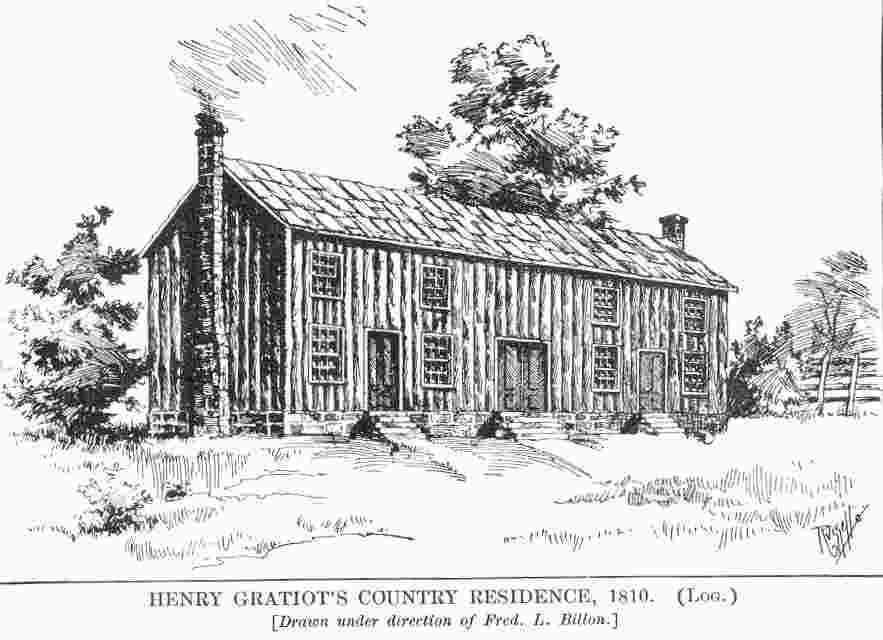OVERVIEW
- 1797 - 1845: FARMERS AND LAND OWNERS
- 1797 - 1833: THE GRATIOT FAMILY
- 1833 - 1945: BILL SUBLETTE
- Minor story: Sulphur Springs Resort
- 1852 - 1898: ECONOMIC AND SOCIAL/RELIGIOUS DEVELOPMENT
- ECONOMIC DEVELOPMENT
- 1852: The Coming of the Pacific Railroad.
- 1852 - 1898: The development of clay mining and brick making.
- SOCIAL AND RELIGIOUS DEVELOPMENT
St. James Parish: Founded in 1860.
- Minor stories in the 1852 - 1898 period
- 1858 - 1864: The Icarian Utopian Communist Society
- September 24, 1864: Confederate Raid on U.S. Post Office in Cheltenham
- A few comments on the ETHNIC MAKE-UP OF DOGTOWN. Is it really IRISH?
THE GRATIOT LEAGUE SQUARE
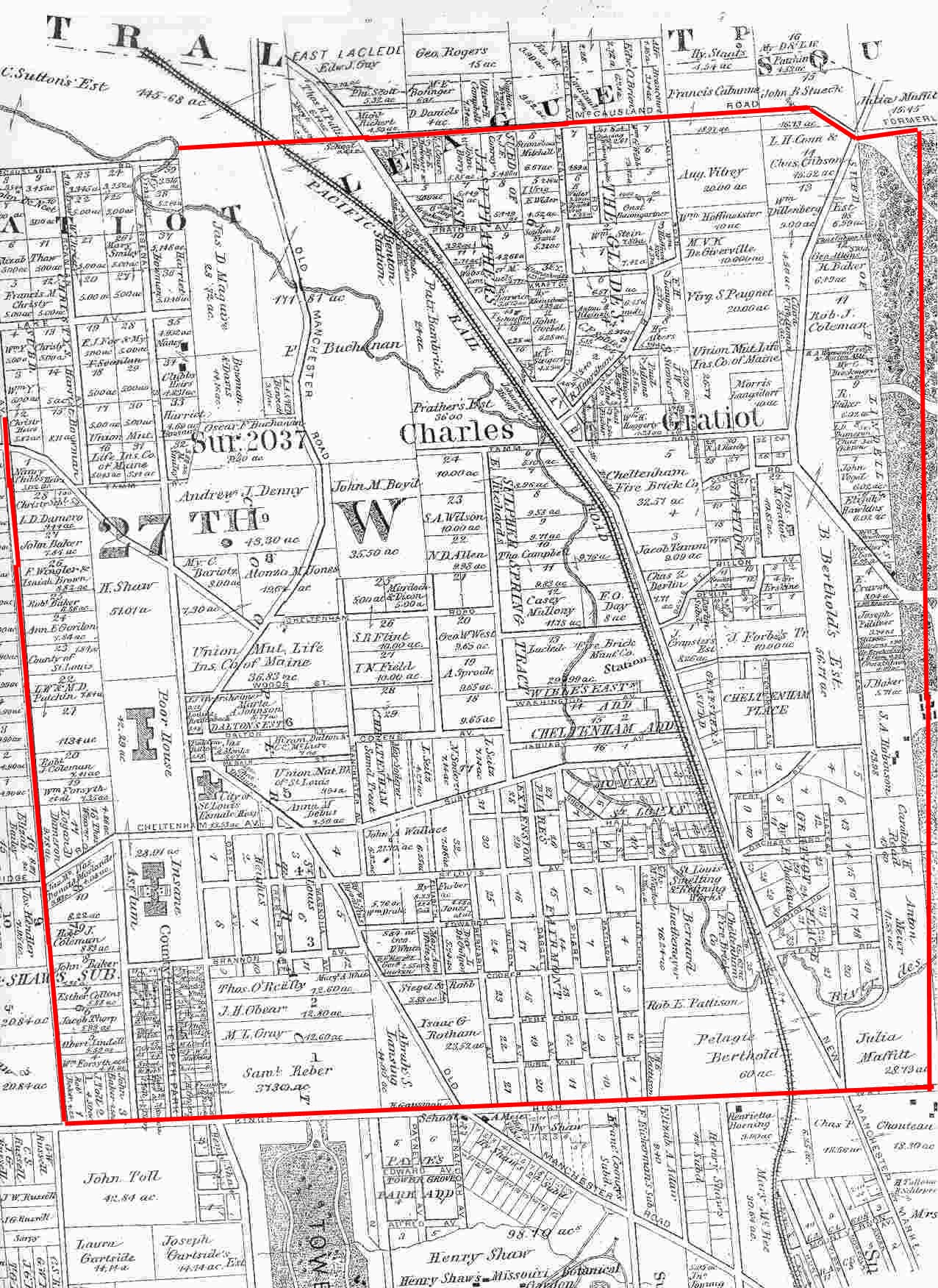
CHARLES GRATIOT
SOME KEY GRATIOT DATES
- 1752 -- Born in Lausanne, Switzerland. Family from France.
- 1776 -- following: Distinguished himself in American Revolution.
- 1780 -- Came to St. Louis: Aged 28. NOT POOR!
 Purchased a home at Chestnut and 2nd St.
Purchased a home at Chestnut and 2nd St.
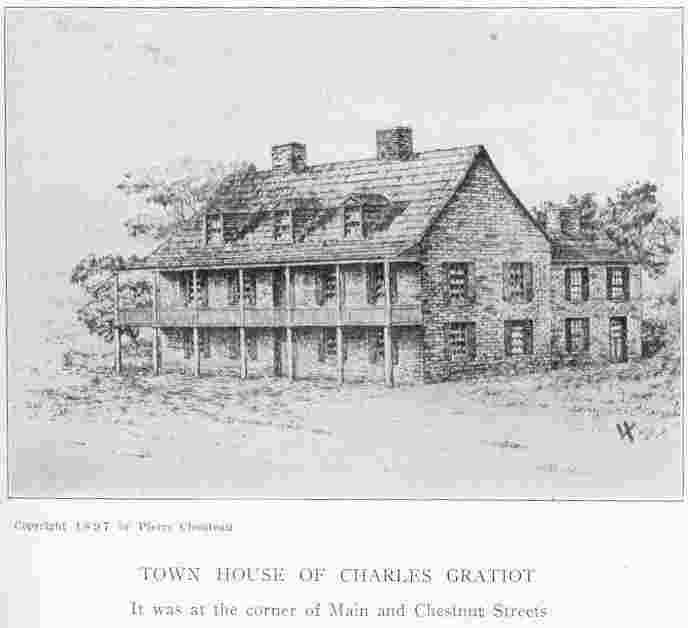
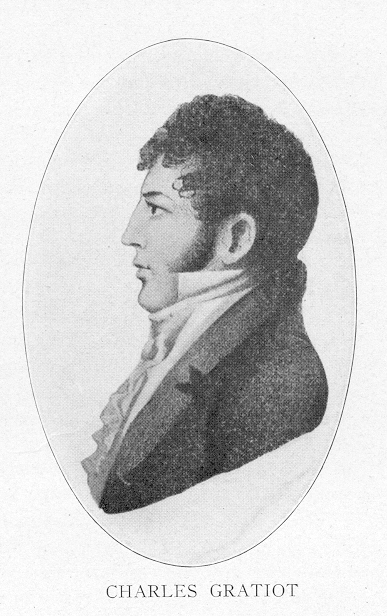
- 1785 -- Made application to the Spanish for a large land grant
"to cultivate wheat, hemp, corn, tobacco, etc., etc." (Gill, 268.)
- 1798 -- Grant was finalized by the Spanish Governor Gayoso de Lemos.

INTERRUPTION TO DEAL WITH SOME PUZZLES
THREE NATIONS AND THEIR INTERESTS
A FEW KEY DATES AND REMINDERS
- 1762 -- France ceded Louisiana to Spain as part of the secret Treaty of Tontainebleau.
- Both Gratiot's application (1785) and receiving the land grant (1798) were when
Spain owned Louisiana.
- 1790 -- Gratiot's first home in OUR NEIGHBORHOOD was built.
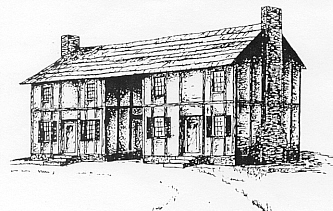
- 1800 -- Oct. 1st. In the Treaty of San Ildefonso France secretly obtained the retrocession of Louisiana from Spain.
- 1803 -- December. France takes possession of Louisiana.
- 1804, March 9th. France OFFICIALLY assumes control.
- 1804, March 10th. France OFFICIALLY turns Louisiana over to the United States.

WHAT IN THE WORLD WAS GOING ON HERE?
Two different historical views to put the Gratiot land grant into
a larger geo-political context
- THE TRADITIONAL HISTORICAL VIEW:
"The supremancy of England on the high seas at this period practically prevented France from instituting any possessory act by transferring troops to the newly-acquired territory, and she wisely resolved to accept the offer of the United States and sell the vast territory to that Government."
- A much more complex view: Napoleon's interrupted "West Indians Policy" makes Louisiana worthless.
Napoleon's West Indian Policy and the Haitian "Gift" To The United States
Bob Corbett
September 1991

GETTING BACK MORE EXPLICITLY TO THE DEVELOPMENT OF OUR NEIGHBORHOOD
Note that The Gratiot League Square was FAR FAR from St. Louis.

Two views of the basically same Gratiot home:
Photo of 1790 house taken from Stevens, 1909.
Photo of 1810 house taken from Billon, 1888.

Charles Gratiot in his later years

Recall that in 1808 the United States confirmed Charles Gratiot's land grant and
he held much of the land until he died in 1817 at the age of 65. He was a judge and very prominent figure in
St. Louis business and politics. After he died his land was divided in to 12 narrow
east-west strips of land. Each strip was only about 1,000 feet wide, but three miles long.
Each of his 12 children received one of the pieces, though some of the land had already been
sold to other people.
The Charles Gratiot era in our neighborhood was, then,
from the building of his first home in 1797 until his death in 1817.

TWO GRATIOT CHILDREN ARE ESPECIALLY NOTEWORTHY IN OUR AREA
- The real plum went to Henry Gratiot: He got the River Des Peres Valley section that figured so prominently
in the next 100 years of our history.
Henry didn't like St. Louis and did live on his land until 1831,
the moved into St. Louis. He sold much of his property to Bill Sublette
on March 10, 1831.

The Gratiot home was still there in 1875
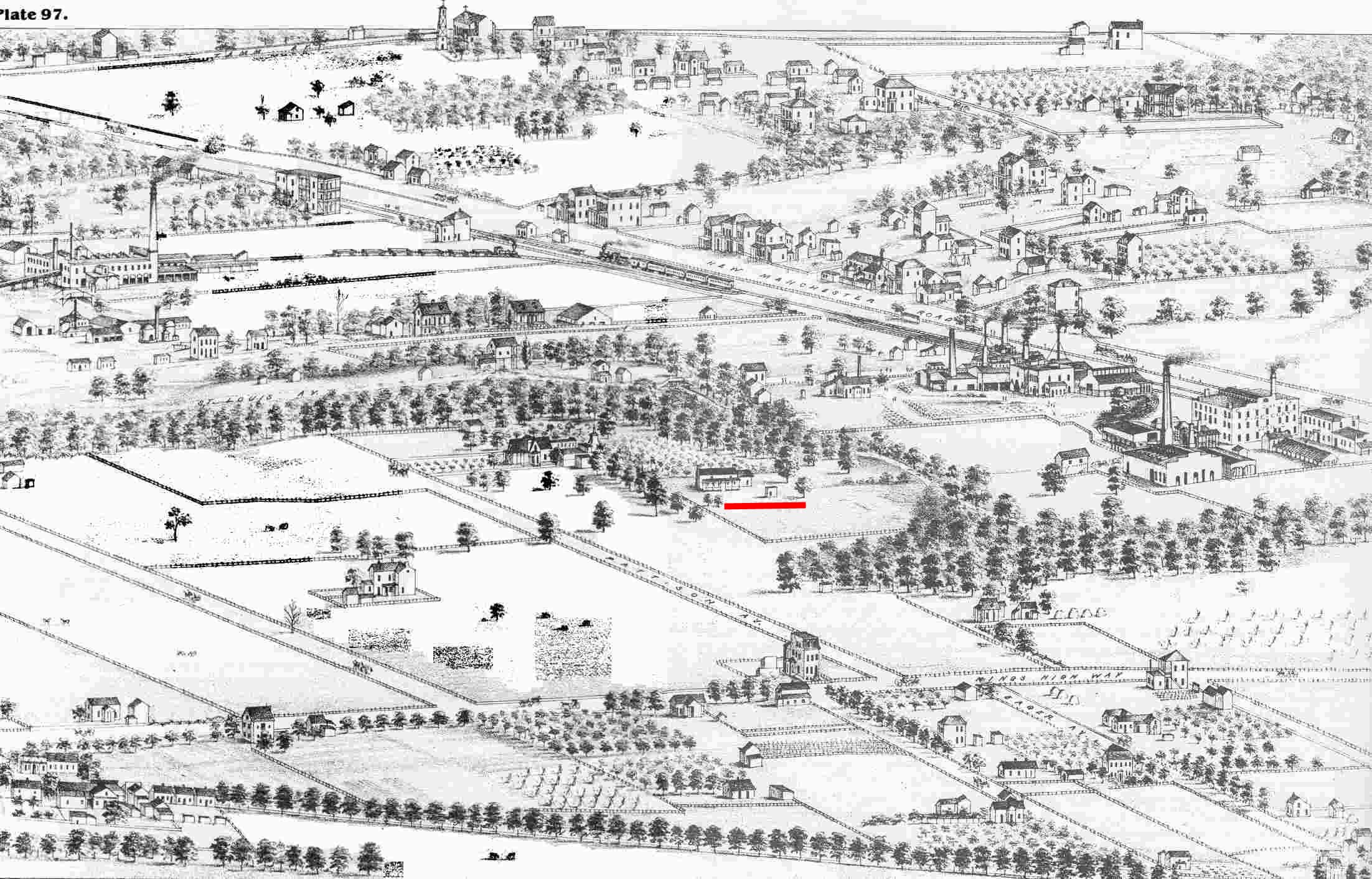
A CLOSE UP OF THE GRATIOT FARM -- 1875
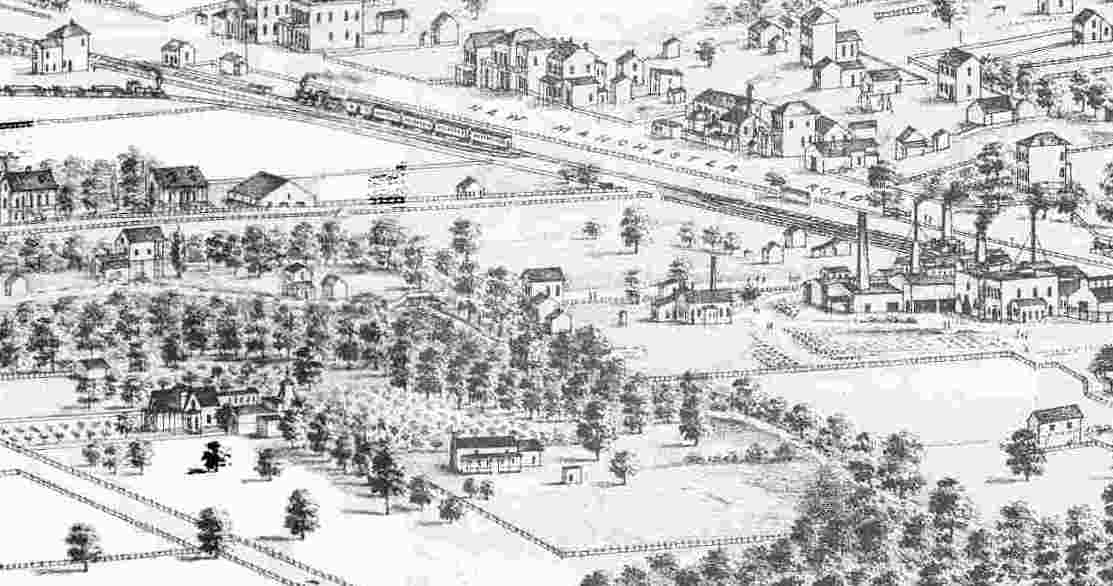
NOTE: COMPARE WITH THE 1797 AND 1810 HOMES AND YOU CAN SEE IT IS
THE SAME HOME.

- Paul Gratiot received the section close to Tamm and Clayton:
Paul's land went from:
1131.9ft. wide n/s, the full 3 miles e/w strip on a line with Wise on the north, and Valley Rd (Dale) on the south.
The family and descendants of Paul Gratiot lived at a large home in the 6200 block of
Victoria until 1959.

THE BILL SUBLETTE YEARS: 1831 - 1845
"Sulphur Springs was his dream of Arcadia-a dream common in his day-an old dream of a golden agricultural age. Over the years he transformed his acreage from a semiwilderness into a prosperous farm and watering place. In his old age he hoped to reside there permanently, surrounded by well-tilled fields and superior livestock. His accumulated fortune, income from his partnership, and whatever he might derive from operating part of his farm as a watering place would be more than enough, he thought, to provide for his every comfort."
(p. 175 of BILL SUBLETTE: MOUNTAIN MAN by John E. Sunder, 1959.)

The famous "stone house" which Bill Sublette had built -- finished in the summer of 1835
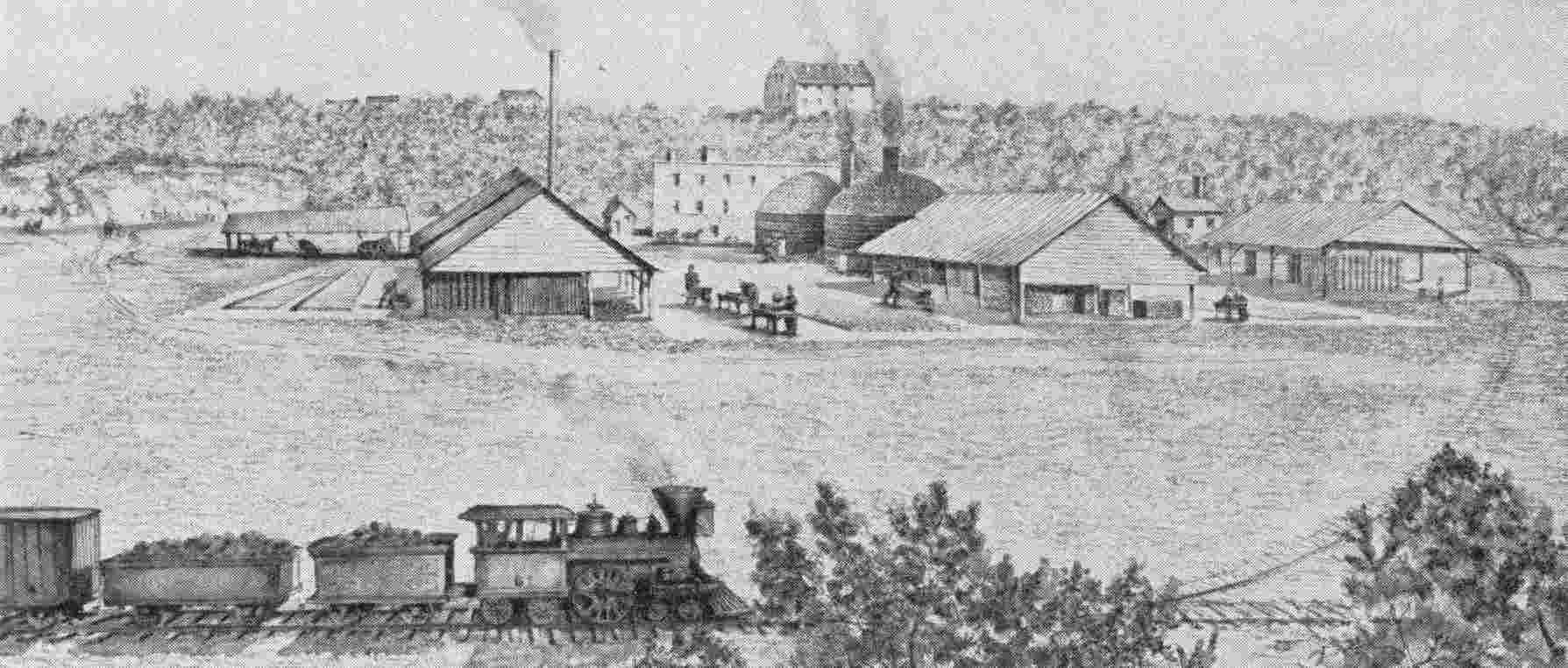





KEY DATES AND ACTIVITIES OF BILL SUBLETTE
- Birth date is uncertain, thought to be about 1799.
- 1831 purchased much of the River des Peres Valley in our area from Henry Gratiot.
- Built his famous stone home in 1835.
- Began the first mining in the area in the early 1840s.
- Entered the property from "Old Manchester Road" (Southwest Ave.)
- In wet weather mules and horses couldn't pull the heavy wagons to market, so Sublette purchased
teams of oxen.
- Built a stone bridge over Vandeventer for better access to his property.
- Eventually had "New" Manchester Road built.
- Opened the Sulphur Springs resort.
- Died in 1845 and never got to retire to his utopian spot.

NAMES OF THIS AREA
- 1797-1831: GRATIOT LEAGUE SQUARE.
- 1831-1845: SUBLETTE'S FARM AND DRY HILL
- 1844-1850s: SULPHUR SPRINGS
- Mid-1850s - 1876: CHELTENHAM
- 1876-Turn of the Century: CHELTENHAM / DOGTOWN
- 20th Century: MANY NAMES:
- Cheltenham
- Dogtown
- Hi-Pointe
- Franz Park
- Benton

THE FASCINATING BUT SHORT LIFE OF SULPHUR SPRINGS RESORT
Sublette oversaw the resort from 1838 - 1842.
Waters were analyzed for content and found to be much like the
waters of Sulphur Spring, Virginia. Thomas Thompson managed the resort that
accomodated 60 visitors.
1838 he added horse racing.
The resorts always suffered management problems and after Sublette's death
in 1845 it came into the hands of William Wibble who was from Cheltenham, England.
He renamed the resort to THE CHELTENHAM INN and thus the
area took it's first "official name" when it was incorporated into St. Louis County and later,
(1876) into St. Louis City.

- 1797 - 1845: FARMERS AND LAND OWNERS
- 1797 - 1833: THE GRATIOT FAMILY
- 1833 - 1945: BILL SUBLETTE
- Minor story: Sulphur Springs Resort
- 1852 - 1898: ECONOMIC AND SOCIAL/RELIGIOUS DEVELOPMENT
- ECONOMIC DEVELOPMENT
- 1852: The Coming of the Pacific Railroad.
- 1852 - 1898: The development of clay mining and brick making.
- SOCIAL AND RELIGIOUS DEVELOPMENT
St. James Parish: Founded in 1860.
- Minor stories in the 1852 - 1898 period
- 1858 - 1864: The Icarian Utopian Communist Society
- September 24, 1864: Confederate Raid on U.S. Post Office in Cheltenham
- A few comments on the ETHNIC MAKE-UP OF DOGTOWN. Is it really IRISH?
December 9, 1952: THE COMING OF THE PACIFIC RAILROAD
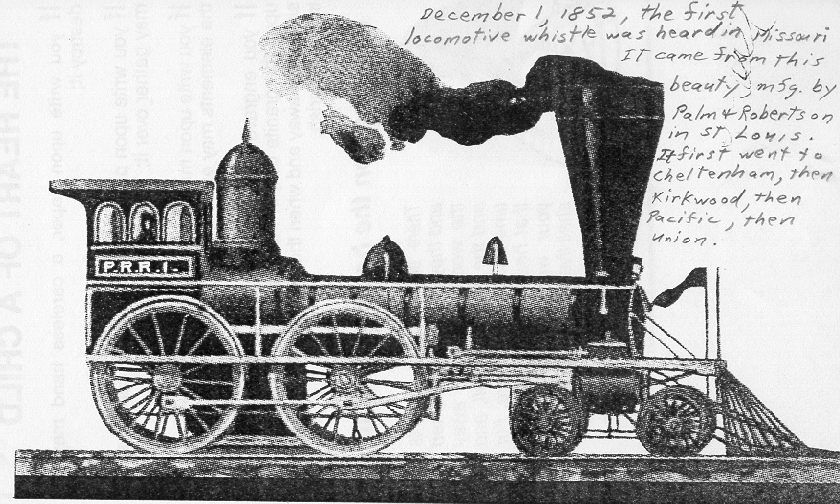
IMMEDIATE DEVELOPMENT OF THE MINING AND BRICK INDUSTRY



THE COMING OF ST. JAMES PARISH -- EARLIEST SIGNIFICANT
SOCIAL AND RELIGIOUS ORGANIZATION
A few key dates and developments
- 1860: Father John O'Sullivan opened a mission of St. Malachy's.
- 1861: First church dedicted -- burned in April 1891.
- 1861-1866: Pastor, Father Michael Welby
- First St. James School in Father Welby's tenure.
- 1867-1869: St. James was again a mission of St. Malachy's.
- 1869-1870: Father Thomas Manning was pastor.
- 1870-1878: Father Henry Kelly -- born in Ireland and beloved pastor.
- 1873 period Father Kelly tried to maintain a school.
- 1878-1884: Father Thomas Ambrose Butler
- 1884-1896: Father Patrick J. McNamee
- 1896-1916: Father Edmond Casey
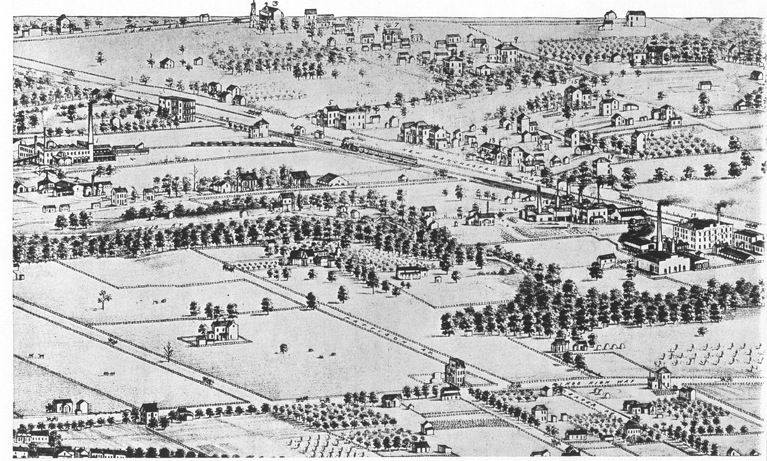

OVERVIEW
- 1797 - 1845: FARMERS AND LAND OWNERS
- 1797 - 1833: THE GRATIOT FAMILY
- 1833 - 1945: BILL SUBLETTE
- Minor story: Sulphur Springs Resort
- 1852 - 1898: ECONOMIC AND SOCIAL/RELIGIOUS DEVELOPMENT
- ECONOMIC DEVELOPMENT
- 1852: The Coming of the Pacific Railroad.
- 1852 - 1898: The development of clay mining and brick making.
- SOCIAL AND RELIGIOUS DEVELOPMENT
St. James Parish: Founded in 1860.
- Minor stories in the 1852 - 1898 period
- 1858 - 1864: The Icarian Utopian Communist Society
- September 24, 1864: Confederate Raid on U.S. Post Office in Cheltenham
- A few comments on the ETHNIC MAKE-UP OF DOGTOWN. Is it really IRISH?
THE ICARIAN UTOPIAN COMMUNIST SOCIETY
A FEW KEY FACTS OF THE ICARIAN COMMUNITY
- The "Terror" or counter-revolution to the French Revolution of 1789
spawned a large movement of utopian communities.
- These folks despaired of the "general" community being able to live out the ideas of the French
Revolution: liberty, equality and fraternity
- They decided to withdraw from society and form utopian communities.
- ETIENNE CABET while in prison in France, read Thomas More's UTOPIA.
- He decided to form such a community.
- He formed a radical Christian socialistic community.
- In 1848 they arrived in New Orleans.
- The first community in Texas failed within a year.
- 1849-1859 The most successful years were in Nauvoo, Ill.
- In 1856 when this community split and failed, Etienne Cabet and his "remnant" faithful to his vision moved
to St. Louis.
- In 1858 they rented the old Sublette mansion and out-buildings.
- That community eventually failed from internal discension in 1864.
- Some form of the commuity existed in 1886 and today there is a very active society
of descendants of the "French Icarians."






THE 1864 CONFEDERATE RAID ON AUGUSTE MUEGGE'S CHELTENHAM POST OFFICE
SEPTEMBER 29,1864

William C. Winter's description of the raid -- From: THE CIVIL WAR IN ST. LOUIS.
St. Louis: Missouri Historical Society Press, 1994.
Postmaster Augustus Muegge of Cheltenham arrived at the militia camp on Olive Street Road around 8:00 P.M. on September 29, 1864. He frantically told his story: he and his wife had been attacked by Confederate raiders. Union troops were sent in pursuit out Laclede Station Road but gave up when they reached Old Watson Road and had seen no signs of the marauders. If Muegge was right, this was the only appearance of armed secessionists in St. Louis since the days of Camp Jackson in 1861.
The village of Cheltenham was large enough to boast a railroad station and a United States Post Office. The Post Office was half a mile from the station and located inside the Muegge's general store on the corner of Manchester and Valley (now Dale) Avenues. In September 1864 the village was no doubt in a state of alarm, just as St. Louis was, because of the threat from General Sterling Price's advancing Confederate columns.
According to Muegge, four men rode up to his store in the early evening, perhaps as early as 5:00 P.M. Two men remained mounted as the other two dismounted and walked into the store. After looking around, they inquired about the distance to the nearest military post. Mrs. Muegge, suspicious of the visitors' intent, called out a warning to her husband in German to be careful.
Next, the intruders asked about Muegge's politics. He replied that he was a Union man. Then they asked whether he had ever held office. Muegge said he was the United States Postmaster for Cheltenham. In response, one of the men drew his pistol and announced, "It's just such men as you that we want to kill.
The ever alert Mrs. Muegge threw herself between her husband and the intruder, causing the would-be killer to pull up his arm. Heeding his wife's call to run for his life, Mr. Muegge sprang down the hall, went out the back door, and made his escape. As soon as he could find a horse, he made his way to the Union militia camp.
How seriously the Union troops took Muegge's report is difficult to determine. The Missouri Republican reported just after the event that a scout was sent out "immediately." The Missouri Democrat claimed that, despite considerable effort on Muegge's part to get the Union troops interested, he could find no one "who had authority to act."
 Purchased a home at Chestnut and 2nd St.
Purchased a home at Chestnut and 2nd St.


 Purchased a home at Chestnut and 2nd St.
Purchased a home at Chestnut and 2nd St.







